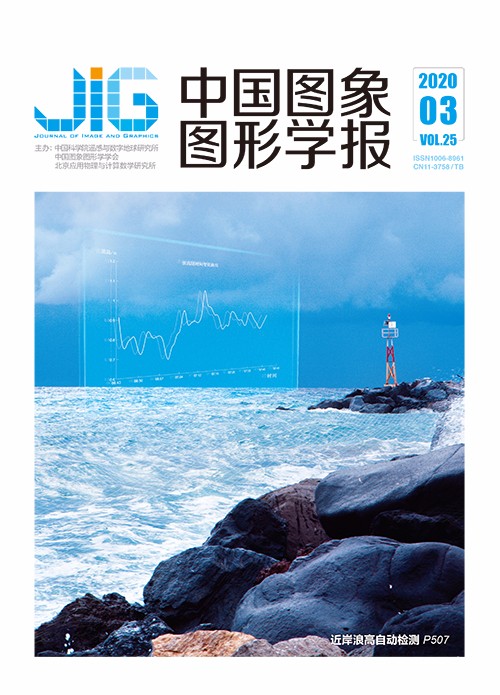
结合视觉密码和离散小波变换的栅格地理数据双重水印
摘 要
目的 在栅格地理数据的使用过程中,为防止数据被破坏或被篡改,需要加强对数据完整性的检验;为防止数据被恶意传播,需要加强对数据版权信息的保护。双重水印技术可以同时完成这两项任务。方法 利用基于异或的(2,2)-视觉密码方案VCS(visual cryptography scheme)和离散小波变换DWT(discrete wavelet transform),对数字栅格地理数据嵌入双重水印,使用半脆弱性水印作为第1重水印进行完整性检验,水印信息依据DWT变换后高频系数中水平分量之间的大小关系嵌入;使用零水印作为第2重水印进行版权保护,提取DWT变换后经低频子带奇异值分解的特征值生成特征份,利用基于异或的(2,2)-VCS,根据特征份和水印信息生成版权份。结果 为验证算法的有效性,对具体的栅格地理数据进行实验分析。结果表明,本文算法中第1重水印能够正确区分偶然攻击和恶意破坏,对含水印的栅格地理数据进行质量因子为90、80、70、60、50的JPEG压缩后,提取出完整性水印的归一化相关系数NC(normalized correlation)值分别是1、0.996、0.987、0.9513、0.949,在定位裁剪攻击时,能准确地定位到篡改的位置,对于定位替换攻击时,能定位到篡改的大致位置;第2重水印具有良好的视觉效果和较强的鲁棒性,对含水印的栅格地理数据进行滤波攻击、JPEG压缩、裁剪攻击、缩放攻击等性能测试,提取出版权水印的NC值优于其他方案。结论 论文基于异或的(2,2)-VCS和DWT提出的栅格地理数据双重水印算法,在实现数据完整性检验的同时达到了版权保护的目的。
关键词
Raster geographic data dual watermarking based on visual cryptography and discrete wavelet transform
Fang Liguo, Fu Zhengxin, Sun Wanzhong, Yu Bin(Information Engineering University, Zhengzhou 450001, China) Abstract
Objective Raster geographical data are important and sensitive. Once the raster geographic data are destroyed or tampered with, security risks to users occur. In addition, if users maliciously disseminate data, many unauthorized users will use the data beyond their authority, which also poses a threat to the data security. Strengthening the integrity of data inspection is necessary to prevent data from being destroyed and tampered with. Strengthening the copyright protection of data is also necessary to prevent raster geographic data from being maliciously disseminated. With the various requirements of integrity checking and copyright protection for watermarking, achieving the requirements of integrity checking and copyright protection at the same time by embedding only one watermarking information in raster geographic data is difficult. If the two technologies are combined, then the protection of raster geographic data will be comprehensive, and the dual watermarking technology can simultaneously achieve integrity checking and copyright protection. Method XOR(2,2)-VCS and discrete wavelet transform (DWT) are used to embed double watermarking into digital raster geographic data. Semi-fragile watermarking is used as the first watermarking for integrity test. The watermarking information is embedded according to the size relationship between the horizontal component HL in the high-frequency coefficients after DWT transformation, which can correctly distinguish between accidental and malicious attacks, and accurately locate malicious attacks. Zero watermarking is used as the second watermarking for copyright protection in extracting the eigenvalues of LL sub-bands after DWT transform and singular value decomposition to generate feature copies. XOR-based (2,2)-VCS is used to generate copyright copies according to feature copies and watermarking information. Copyright watermarking is robust and has good visual effect. The algorithm of embedding the double watermark is as follows. First, the raster geographic data is separated into red, green, and blue gray images. Second, the blue gray image is transformed by DWT, and the watermark image W1 is scrambled by Arnold. Third, the scrambled watermark image W'1 is embedded into the HL sub-band. Fourth, the red gray image is scrambled by Arnold, and then the scrambled red gray image is transformed by DWT. Fifth, the eigenvalue is calculated by singular value decomposition (SVD) operation for the LL sub-band, and the copyright share W22 is generated according to W2 and W21 by XOR (2,2)-VCS, which is saved by the copyright party. Sixth, the blue and red gray images of the watermarked image are obtained by inverse discrete wavelet transform (IDWT) transformation of each sub-band, which are synthesized with the green gray images to obtain the watermarked raster geographic data. The algorithm of extracting double watermark is as follows. First, the watermarked raster geographic data is separated into red, green, and blue gray images. Second, the blue gray image is transformed by IDWT, and the scrambled watermark image is extracted from the HL sub-band. Third, the watermark image is extracted by Arnold. Fourth, the red gray image is scrambled by Arnold, and then the scrambled red gray image is transformed by DWT. Fifth, the eigenvalue is calculated by SVD operation for the LL sub-band, and the copyright watermark image is generated according to copyright share and eigenvalue share by XOR (2,2)-VCS. Result To verify the effectiveness of the algorithm, we analyzed the specific raster geographic data experimentally using the proposed algorithm. The experimental results show that the integrity watermark in this algorithm can correctly distinguish between accidental attack and malicious damage. After JPEG compression with quality factors 90, 80, 70, 60, and 50, the normalized correlation (NC) values of the extracted integrity watermark are 1, 0.996, 0.987, 0.9513, and 0.949, respectively. When locating the tailoring attack, the algorithm can accurately locate the tampered position. When locating the replacement attack, the algorithm can locate the tampered approximate position. Copyright watermarking has good visual effect and strong robustness. As the embedding and extracting of the copyright watermark have no change to the raster geographic data itself, the attacker cannot detect whether the raster geographic data contain a watermark image. Obtaining the feature copies is difficult, and even if the eigenvalue share is obtained, the copyright share cannot be obtained because no copyright watermark information exists. The NC value of the copyright watermark is better than that of other schemes by testing the performance of the watermarked raster geographic data such as filtering attack, JPEG compression, tailoring attack, and scaling attack. Conclusion According to the requirement of integrity checking and copyright protection of raster geographic data, on the basis of deeply analyzing the characteristics of raster geographic data, integrity checking and copyright protection technology, an algorithm of integrity checking and copyright protection of raster geographic data is proposed based on DWT and VCS. The algorithm uses DWT and XOR (2,2)-VCS to embed double watermarking into raster geographic data. Semi-fragile watermarking is used as the first watermarking for integrity checking and zero watermarking is used as the second watermarking for copyright protection. Experiments show that the integrity watermarking can accurately locate the malicious damage, and the copyright watermarking is robust and has good visual effect.
Keywords
raster geographic data visual cryptography discrete wavelet transform digital watermarking integrity check copyright protection
|



 中国图象图形学报 │ 京ICP备05080539号-4 │ 本系统由
中国图象图形学报 │ 京ICP备05080539号-4 │ 本系统由